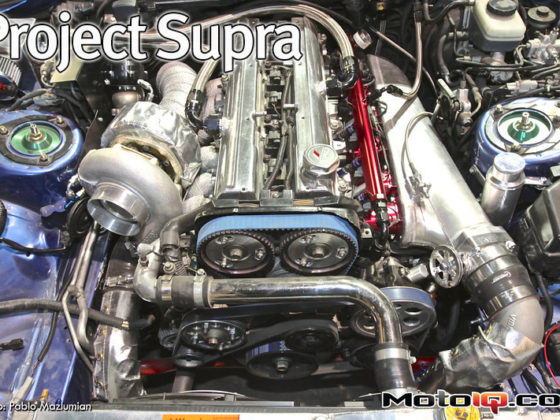
Project Grey Mustang 5.0: Part 4 – Improving Drivability and Reliability
The Grey Project Mustang 5.0 is still alive and kicking. Over the past year, it’s had a lot of little things done to it to improve drivability and reliability.
Read more about the Grey Project Mustang 5.0 here!
The Mustang drove and handled great with the suspension mods performed to it, at least for the most part. The only “problem” was throttle response. On most newer engines, including the Coyote 5.0L found in Project Mustang, the throttle is not connected to a pedal via a cable. Instead, the throttle plate is controlled by a stepper motor, which is, in turn, controlled by the Powertrain Control Module (PCM). This is known as Drive-By Wire (DBW). Instead of directly opening the throttle plate like on cable-operated throttles, the pedal simply sends an electronic number to the PCM. Using this number and several other parameters such as engine RPM and coolant temperature, the PCM creates a torque target value. Using this torque target, the PCM looks up values in a table to arrive at the intended torque value by changing a variety of parameters, including throttle position, spark advance, ignition timing, and cam timing. This means that the throttle position no longer directly corresponds to the accelerator pedal’s position.
In order to make the car drivable by your average unskilled driver, throttle response is deadened and torque output is limited below 4,500 RPM or so. (This is how a soccer mom can drive a RWD pony car that has more horsepower than the original Viper. It is also why, around town, you can’t tell the difference between a V6 and V8 Mustang until you hammer it.)
 Ford Coyote 5.0. 32 Valves. Dual Overhead Camshafts with Twin Independent Variable Cam Timing. 430 horsepower. Mountains of Torque. And throttle response rivaled only by that of a 2002 Toyota Yaris.
Ford Coyote 5.0. 32 Valves. Dual Overhead Camshafts with Twin Independent Variable Cam Timing. 430 horsepower. Mountains of Torque. And throttle response rivaled only by that of a 2002 Toyota Yaris.In order to solve these problems, I ordered a new “tune” for the PCM from Ford Racing. Ford Racing’s tunes are developed by the same engineers who designed the motor. Because of this, all emissions functions are maintained, reliability is still as good as stock (no blown cylinders from bad tunes here!), and the factory warranty is still retained. Also, whereas other tuners simply change values in lookup tables for their tunes, Ford Racing actually inserts and changes lines of code, meaning they can do things the other tuners simply can’t do, such as changing cam timing behavior or modifying shifting strategies on automatic transmissions.
After sending them my car’s VIN, a Ford Racing ProCal showed up at my doorstep a few days later. Installing the new tune is a simple matter of plugging the ProCal into the OBD-II port, pressing a few buttons, and waiting about 15 minutes. The car fired up immediately afterwards.
 The ProCal is a small, handheld device that replaces the factory tune with Ford Racing’s. The factory tune is stored on the ProCal’s memory in case you want to later return the car to stock. It also allows you to adjust the speedometer for different diameter tires or final drive gears.
The ProCal is a small, handheld device that replaces the factory tune with Ford Racing’s. The factory tune is stored on the ProCal’s memory in case you want to later return the car to stock. It also allows you to adjust the speedometer for different diameter tires or final drive gears.The difference in driving was immediately apparent. Throttle response was much better—and very linear. It felt much closer to an older muscle car that wasn’t DBW. Flooring the pedal no longer required waiting for an electronic committee to vote on whether or not to give me full torque. There was a nice bump in power, too. By requiring 91 octane or higher, Ford was able to tweak the spark advance and a few other parameters, giving a claimed peak power increase of 16 horsepower and 7 lb-ft of torque.
But those peak numbers are not what make the new tune so great. The area under the curve is the true improvement, because by eliminating torque management, the ProCal tune increases output by over 60 lb-ft of torque at 1,500 RPM. This is like removing the seal on Pandora’s Box. Flooring the car at the starting line of an autocross makes the horizon fly towards you at an alarming rate. The increase of torque at lower RPMs also makes the engine very linear, which is one of the greatest advantages of a large-displacement, naturally-aspirated engine used for corner carving. This tune was so transformative that I wished I had installed it on the second day I owned the car. The car no longer moves; it spins the earth beneath its wheels.
After taking care of the last of the drivability issues, it was time to address several minor problems that crept up after a couple years of hard driving and racing. Because the grey Mustang is an early 2011 model, several of the options the white ‘13 Project Mustang are equipped with were unavailable at the time, like the Torsen differential and the 4-piston Brembo brakes.
 The stock 2011+ “base-model GT” brakes are a two-piston sliding caliper type with 13.2” rotors. Pre-2011 S197s have 12.4” rotors with the same caliper. While more than adequate for street driving and hard stops after drag races, these brakes begin to fade, wear out, and warp rather quickly when subjected to repeated hard braking at autocrosses and road courses.
The stock 2011+ “base-model GT” brakes are a two-piston sliding caliper type with 13.2” rotors. Pre-2011 S197s have 12.4” rotors with the same caliper. While more than adequate for street driving and hard stops after drag races, these brakes begin to fade, wear out, and warp rather quickly when subjected to repeated hard braking at autocrosses and road courses.


